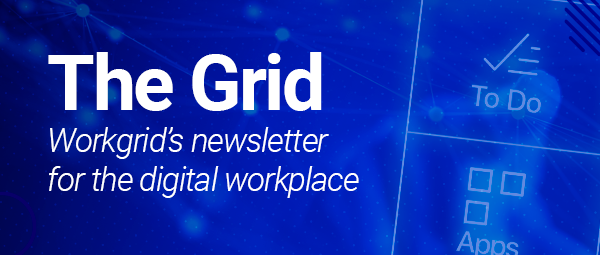The recent DWG Tech Lab was an eye opening event, with three hours of nitty gritty discussions about the tech challenges, successes and advice from both practitioners and vendors focused on the goal of creating an employee focused digital experience.
A number of key takeaways emerged from these sessions, such as:
The increased importance of the digital employee experience given the sudden (and likely permanent) focus on remote work
The need to look beyond the logistics of managing the workplace challenges brought on by the pandemic to forward thinking issues related to improving the digital workplace
The value of integration and the need to select digital workplace solutions that can work across all the apps in an organization, breaking down silos and enabling intelligent self-service functionality that makes employees more productive
The role of intranets in the employee experience and the need for them to provide modern functionality that will bring them up to speed with current needs and expectations
Improving enterprise search
In the roundtable discussions led by our Co-founder and CTO Gillian McCann and Director of Partnerships & Strategy, Frank Pathyil, enterprise search functionality was also a major focus. We discussed the challenges and possibilities of search with practitioners from a wide variety of organizations. What we learned is that while companies love the vision of contextual, personalized and intent-driven search functionality, it was viewed as more of a mirage on the horizon rather than anything they were prepared to tackle right now.
That’s understandable. Executing a powerful, contemporary search function is a huge undertaking that requires a significant amount of foundational work (e.g. resolving internal politics, solving tagging issues and establishing appropriate levels of governance.) to get right. Not easy to do, especially with more pressing issues at hand.
But while enterprise-grade search functionality might have to be shelved as a future initiative, one insightful question from an attendee did get everyone’s wheels turning:
How can harnessing employee data change everything?
Organizations are all sitting on a goldmine of data that, if used properly, has the power to transform the day-to-day experience of employees into a consumer-level digital experience that rivals that of giants like Amazon and Netflix. Data is the ultimate employee experience power play that saves time, reduces frustration and helps to attract and retain top talent.
So how exactly does the simple use of data make that kind of magic happen? Here are just a few of the ways…
Four ways employee data can improve the employee experience
1. More personalized search results
Creating enterprise-level search functionality that can scour all data repositories and return useful answers rather than links may be a stretch goal at this point, but there’s a baby step you can take right now that will put you on the right path for long-term success. Use data to at least personalize search and ensure that the key word search results employees currently get are relevant. Take questions related to office holidays or policies for example. Answers can vary widely for employees around the globe, so using information such as location to customize query responses makes it possible to significantly reduce the results that aren’t pertinent so employees can focus on the ones that are.
2. Targeted, contextual communications
If there’s one thing employees universally struggle with, it’s the sheer volume of information they have to sift through every day. There’s simply too much of it, which is causing information to get lost or overlooked. Organizations can decrease the stress and frustration felt by employees who are trying to manage the overload by using data to target communications to just the relevant employees who need to see them.
![[asset] to-do-intranet-notifications](https://images.ctfassets.net/z7p73u8c0thn/7ejSGEQ4r64gTn1XLFoDKY/583ea2dce00f249cdf3841b6e7f84012/to-do-intranet-notifications.png?w=641&h=450&q=60&fm=png&bg=transparent)
For example, using data to send targeted communications about scheduled trainings and software updates can add immediate, incremental value to the business. It also sets up a solid foundation that can be built upon down the road, with data being employed to create fully personalized and contextual communication experiences that are able to be consumed wherever employees are (via mobile, intranet, browser, desktop app)
3. Modernized intranet
In addition to receiving too many generic and irrelevant communications, employees also struggle with finding a centralized source for reliable information. An intranet would seem to be a logical solution, but with lots of speculation that intranets are on the brink of demise, they aren’t always considered as a solution to this problem.
It was clear throughout the event that intranets are definitely not dead (a fact supported by Gartner in their report “Traditional Intranets Are Dead — Modern Intranets Are Alive and Well", but it was apparent that they’re struggling to keep up with the times. Organizations can battle this trend of irrelevance by using their intranets as a centralized repository for important tasks and information.
By taking advantage of employee data to serve up targeted content, it not only modernizes the experience, it significantly increases traffic to the site and makes it a useful resource that employees come to trust and rely on. Reminders about office closures or construction updates are examples of just a few easy ways to provide short-term value.
There are also lots of opportunities to create an even more intelligent experience, such as proactive recommendations and notifications based on employee data and preference, such as learning management notifications based on your job role or function, new job postings based on your skillset, etc.
![[asset] Workgrid Intranet Tool Bar Example](https://images.ctfassets.net/z7p73u8c0thn/4bT5Za0oxF6kUAqdMcTHUn/caff7e80b7821fe71010a7a9100002a7/Intranet_To_Dos.PNG?w=1200&h=632&q=60&fm=png&bg=transparent)
4. Saving time on routine tasks
One of the hallmarks of an engaging employee experience is having more time to focus on meaningful work. That can be a challenge, however given the productivity draining list of high-volume, low-value tasks employees are faced with every day. Effective use of employee data can win back a lot of that time, starting with streamlining self service tasks.
![[gif] ITSM Help Desk Ticket Chatbot](http://images.ctfassets.net/z7p73u8c0thn/52t4yOfEN85FT5ITtOBBot/b46ac6a93796ce700ca4aacb53300343/GA_September_ITSM.gif)
Routine help desk inquiries are a great candidate for personalization because they take an inordinate amount of time as workers are forced to continually provide basic data such as name, office location and assigned devices. Organizations can use existing data to automatically fill in all of those blanks, trimming valuable time off each transaction and streamlining the process for employees and help desk workers alike.
There’s no question that the wish list for creating a powerful, engaging employee experience is long. There are lots of features, functionalities and technologies organizations would like to implement ASAP to help their workforce feel less frustrated, and more engaged and productive. All of that will come when the time is right, but in the meantime, taking advantage of existing employee data is a quick and easy way to get some short-term wins that delight employees and deliver business value.

![[asset] Importance of DEX](https://images.ctfassets.net/z7p73u8c0thn/8PIhLTmTONfn8lnmc3MWt/51f025750db1de326933a228a4006e5d/ImportanceofDEX.png?w=658&h=371&q=60&fm=png&bg=transparent)
![[asset] Enterprise Search](https://images.ctfassets.net/z7p73u8c0thn/5SiGVdawNNyaNwzg36Zyqm/61dde0473ac60cff0f1fb1415245e05b/EnterpriseSearch.png?w=1104&h=830&q=60&fm=png&bg=transparent)



